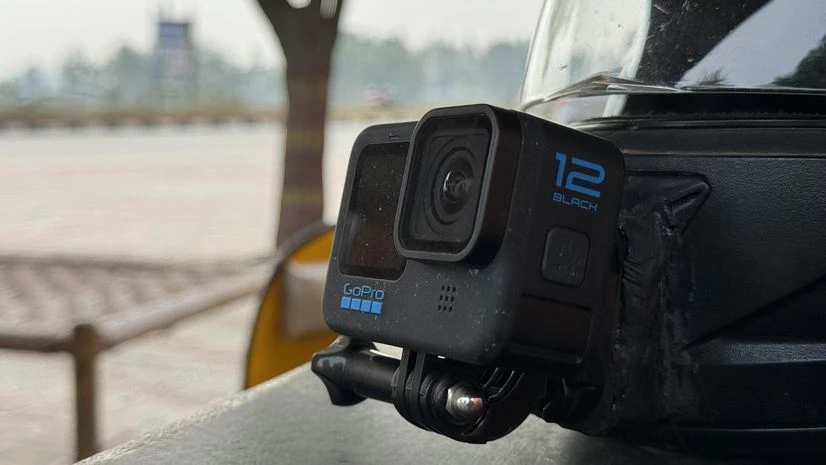GoPro is recognised for its rugged action cameras aimed at outdoor enthusiasts, adventurers, and alike. In the past few years, the company has pivoted to creators-focused features while keeping its devices up to speed in terms of technology. This approach has helped the company come out with products that have something in store for everyone. Case in point is the GoPro Hero 12 Black.
The 2023 iteration of the GoPro action camera maintains the design and specifications of its predecessor, featuring the GP2 chip, a 1/1.9-inch sensor with an 8:7 aspect ratio supporting 10-bit colour capture, a front-facing LCD display, and integrated mounting legs. While the core attributes remain consistent, the Hero 12 Black introduces substantial feature enhancements targeting both professionals and beginners.
For professionals, the Hero 12 Black offers high dynamic range (HDR) capture for photos and videos, GP-LOG encoding in 10-bit colours with provided LUTs for popular video editing software, timecode sync, 1/4-20 mounting threads within mounting fingers, and extended runtimes with the improved "Enduro" battery.
HDR capture, available optionally alongside standard and GP-LOG encoding, supports up to 4K resolution videos at 24 and 30 frames-per-second in 8:7 aspect ratio, and 60fps in 16:9 aspect ratio. Notably, HDR capture enhances colours and widens dynamic range, capturing finer details like shadows and highlights. However, optimal results are achieved in well-lit conditions.
GP-LOG encoding, a professional-grade feature, enables recording with higher dynamic range. While GP-LOG videos demand post-production colour grading, GoPro has thoughtfully included LUTs with the Hero 12 Black to simplify this process. Supporting 10-bit LOG encoded videos in 8:7 aspect ratio, the camera facilitates recording at 5.3K resolution at 30fps and 4K resolution at 60fps.
Timecode sync is a professional feature streamlining metadata synchronization across multiple GoPro cameras. Achieving synchronization is straightforward through the Quik app, ensuring consistent time references and operational synchronicity.
More From This Section
The Hero 12 Black's "Enduro" battery pack marks a substantial improvement in on-battery time, delivering up to 2x longer runtimes compared to its predecessor. Notably, this enhancement is particularly noticeable in experiences involving 4K at 120fps and 5.3K at 60fps, though less pronounced in 4K at 60fps and 30fps.
However, this advancement comes at the expense of a GPS chip, absent in the Hero 12 Black. Consequently, overlaying stickers displaying data from the GPS chip, such as speedometer, terrain, path, and speed chart, are no longer supported.
While the aforementioned features position the Hero 12 Black as an ideal imaging device for professionals, the action camera also incorporates several upgrades catering to aspiring creators and beginners. These enhancements include redesigned controls for simplicity, a dedicated vertical capture mode, and compatibility with wireless microphones.
Simplified controls offer a more streamlined point-and-shoot experience with fewer settings and capture choices. The interface facilitates easy selection of digital lenses and video resolutions, accompanied by brief descriptions for informed decision-making. Additionally, a new vertical capture mode enables the recording of social media-ready vertical videos in landscape orientation, available in both 8:7 and 16:9 aspect ratios.
With built-in microphones featuring noise reduction, the Hero 12 Black ensures clear audio capture, albeit requiring an external microphone in challenging vocal capture environments. Notably, the camera supports Bluetooth wireless microphones, including those integrated into wireless earbuds from brands like Apple, Samsung, Google, and OnePlus. The pairing process mirrors that of other Bluetooth devices on smartphones.
The Hero 12 Black saves audio from both camera and Bluetooth mic separately in the SD card. The audio tracks, however, needs to be synced in post-production since there is a slight but noticeable lag from audio recorded through external microphone. This is not an issue if you import the video from the camera using Quik app through the USB offload or wireless mechanism. Here, however, audio from external mic overrides audio from built-in microphones.
Speaking of Quik app, it has been updated with new features too. The app lets you trim clips, apply digital lenses on recorded videos, adjust frame angles, apply filters, change speed, control volume, and adjust colours, contrast, brightness, etc. The app is particularly helpful in taking out different perspective from a single video file recorded in 8:7 aspect ratio – you can cull out videos in 16:9, 4:3, 8:7, 1:1, 7:8, 3:4, and 9:16 aspect ratios. It essentially means you can ready the video for social media and video streaming services right off from smartphone without needing any third-party app.
In conclusion, the Hero 12 Black represents a comprehensive upgrade catering to diverse user profiles. Priced at Rs 45,000, it emerges as a compelling choice for those seeking a compact camera to complement their content creation journey, offering a versatile set of features suitable for both beginners and seasoned professionals.

)
